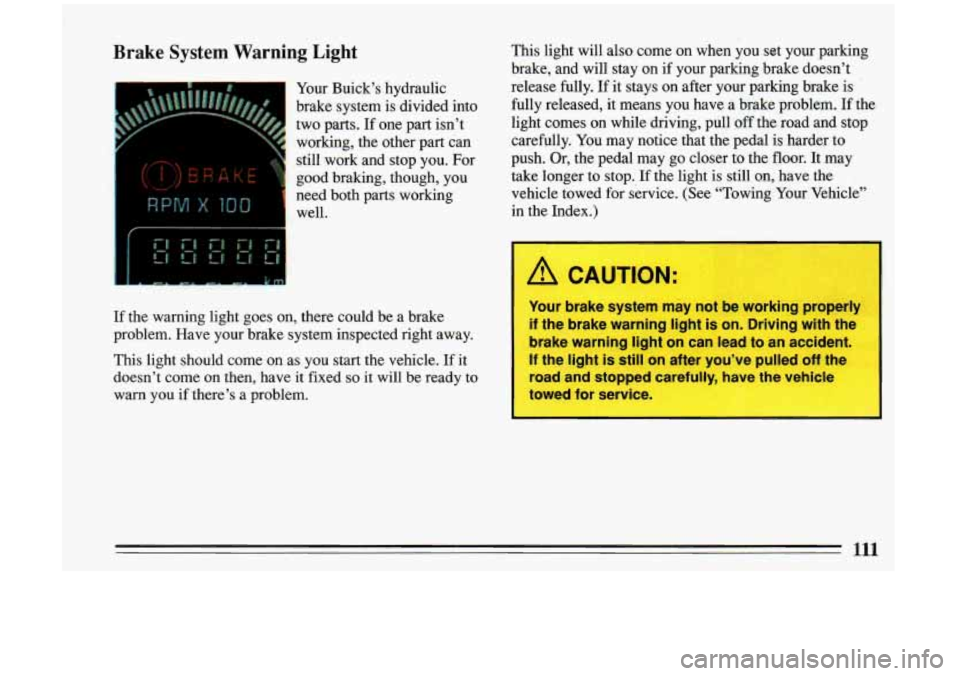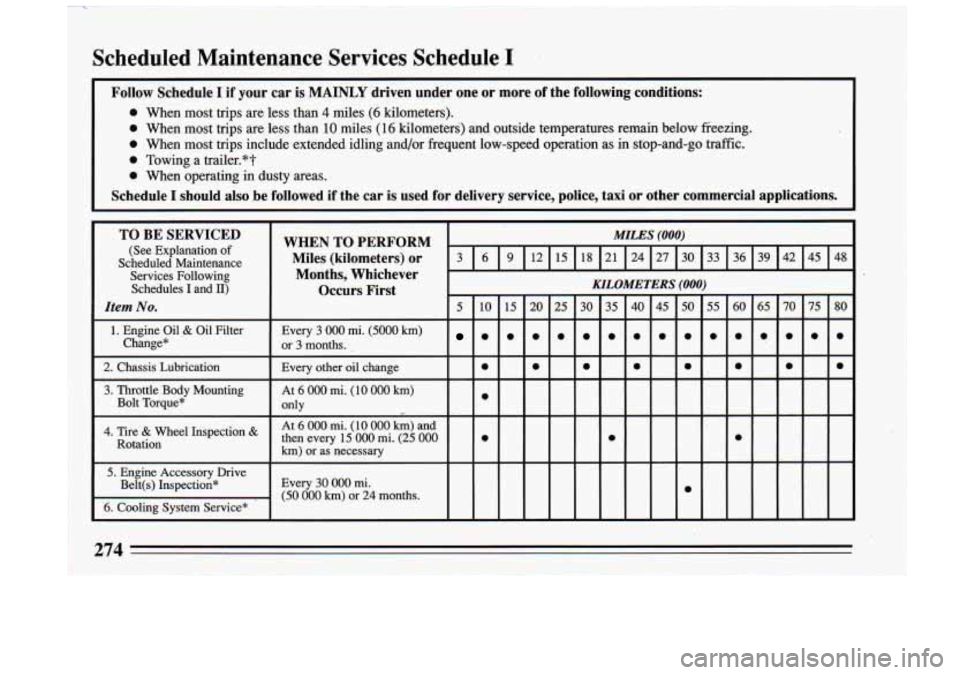Page 113 of 324

Brake System Warning Light
1 Your Buick’s hydraulic
I two parts. If one part isn’t
~ working, the other part can
~ still work and stop you. For ’ good braking, though, you
brake system is divided
into
1 well.
need both parts working
If the
warning light goes on, there could be a brake
problem. Have your brake system inspected right away.
This light should come on as you start the vehicle. If it
doesn’t come on then, have it fixed
so it will be ready to
warn you if there’s a problem. This light will
also come
on when you set your parking
brake, and will stay on if your parking brake doesn’t
release fully. If it stays on after your parking brake
is
fully released, it means you have a brake problem. If the
light comes on while driving, pull
off the road and stop
carefully. You may notice that the pedal is harder to
push. Or, the pedal may
go closer to the floor. It may
take longer to stop. If the light is still on, have the
vehicle towed for service. (See “Towing Your Vehicle”
in the Index.)
I A CAUTION:
Your brake system may not be working properly
if the brake warning light is on. Driving with the
brake warning light on can lead
to an accident.
If the light is still on after you’ve pulled off the
road and stopped carefully, have the vehicle
towed for service.
I
111
i
Page 193 of 324
Towing Your Vehicle Before you do anything, turn on the hazard warning
flashers.
Try to have a
GM dealer or a professional towing
service tow your Buick. The usual towing equipment is When you call, tell the towing service:
a sling-type
(A) Or a wheel-lift (B) Or Car carrier (c) tow 0 That your vehicle has front-wheel drive.
truck.
. The make, model, and year of your vehicle.
If your ‘vehicle has been changed or modified since it
was factory-new by adding aftermarket items like fog
lamps, aero skirting,
or special tires and wheels, these
instructions and illustrations may not be correct.
0 Whether you can still move the shift lever.
If there was an accident, what was damaged.
When the towing service arrives, let the tow operator
-know that this manual contains detailed towing instructions and illustrations. The operator may want to
see them.
191
Page 194 of 324
/! CA TlON:
To help-avok rjury to you or others:
Never let passengers ride in a vehicle that I
Never tow fastt than safe or postec
Never tow ith damaged parts not fully
Never get under your vehicle after it has
Always use separate safety chains on
is being towed.
speec
secured.
been lifted by the tow truck.
each.side when towing a vehicle.
CAUTION: (Continued)
CAUTION: (Continued)
0 Never use “J” hooks. Use T-hooks
instead.
When your vehicle is being towed, have the ignition key off. The steering wheel should be clamped in a.
straight-ahead position, with a clamping device designed
for towing service.
Do not use the vehicle’s steering
column lock for this. The transaxle should be in Neutral
and the parking brake released.
192
Page 276 of 324

Scheduled Maintenance Services Schedule I
Follow Schedule I if your car is MAINLY driven under one or more of the following conditions:
0 When most trips are less than 4 miles (6 kilometers).
0 When most trips are less than 10 miles (16 kilometers) and outside temperatures remain below fieezing.
0 When most trips include extended idling and/or frequent low-spee\
d operation as in stop-and-go traffic.
0 Towing a trailer.*?
0 When operating in dusty areas.
Schedule I should also be followed if the car is used for delivery service, police, taxi or other commercial applications.
TO BE SERVICED
(See Explanation of
Scheduled Maintenance
Services Following
Schedules
I and n)
Item No.
1. Engine Oil & Oil Filter
Change*
2. Chassis Lubrication
3. Throttle Body Mounting
Bolt Torque*
4. Tire
& Wheel Inspection &
Rotation
5. Engine Accessory Drive Belt(s) Inspection*
6. Cooling System Service*
WHEN TO PERFORM
Miles (kilometers) or Months, Whichever MILES (000)
Occurs First
k
Every 3 000 mi. (5000 km)
or 3 months. , I
Every other oil change
At
6 000 mi. (10 000 km)
only
I
At 6 000 mi. (10 000 km) and
then every
15 000 mi. (25 000
km) or as necessary I
Every 30 000 mi.
(50 000 km) or 24 months.
KILOMETERS (000)
30 35
00
0
0
..
45 50 55
000
0
0
65 70
00
0
274
Page 310 of 324
1
Why Wear Safety Belts ? ........................... 19
Windows. Power
................................. 84
Windshield Cleaning
.................................... 256
Washer
...................................... 88
Washer Fluid
................................. 235
Wipers
................................... 87. 256
Winter Driving
.................................. 178
WireWheelCover
............................... 206 Working on Your Car
............................. 216
Worn Tires
...................................... 247
Wrecker Towing
................................. 191
Your Driving and the Road
....................... 139
Your Own Signs
................................. 147
Your Vehicle and the Environment
.................. 271
I
308